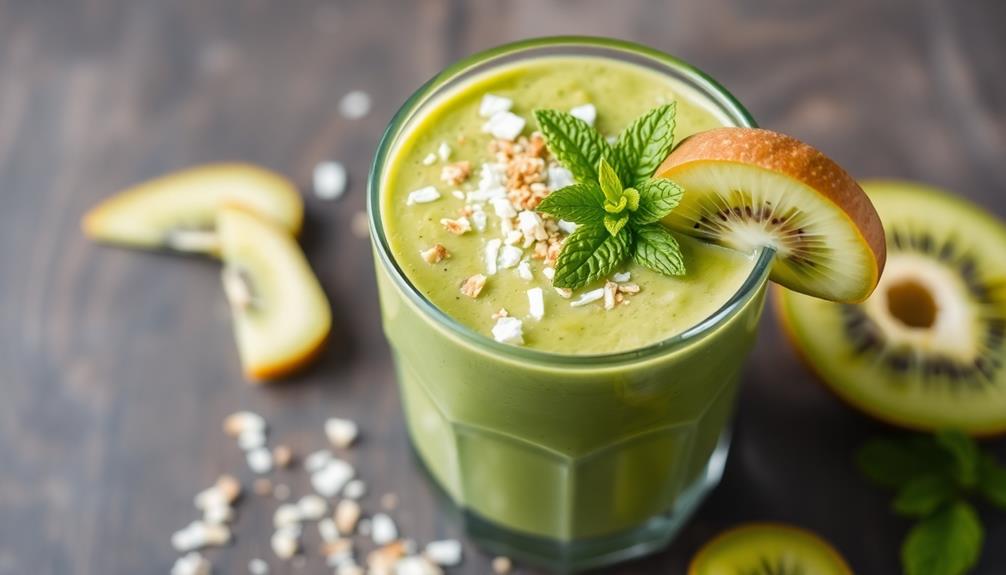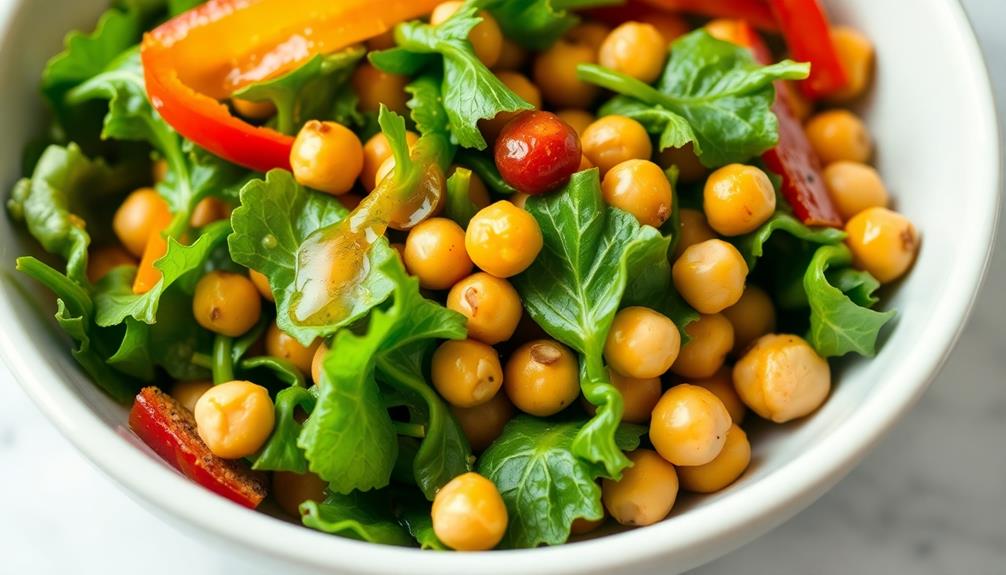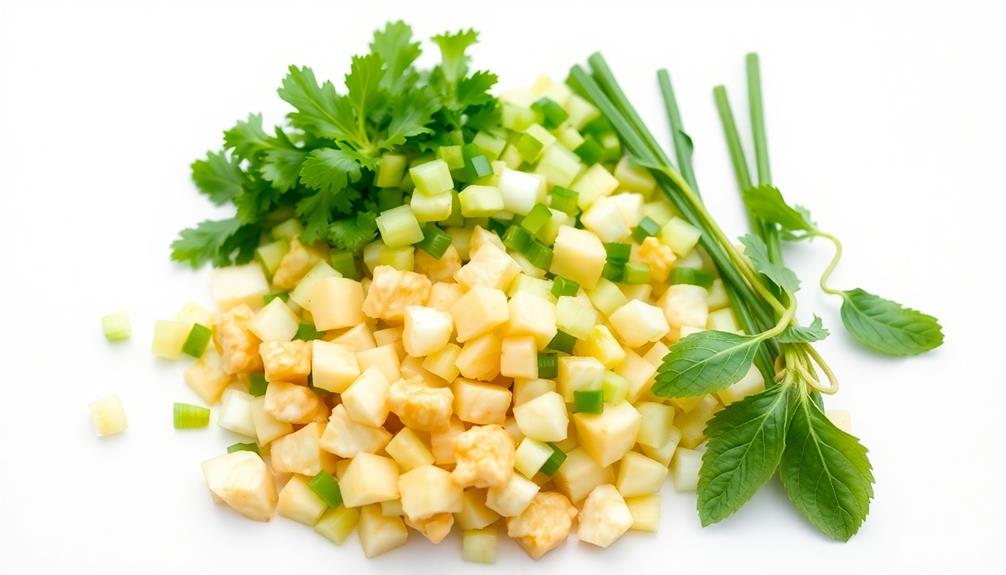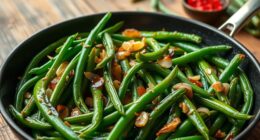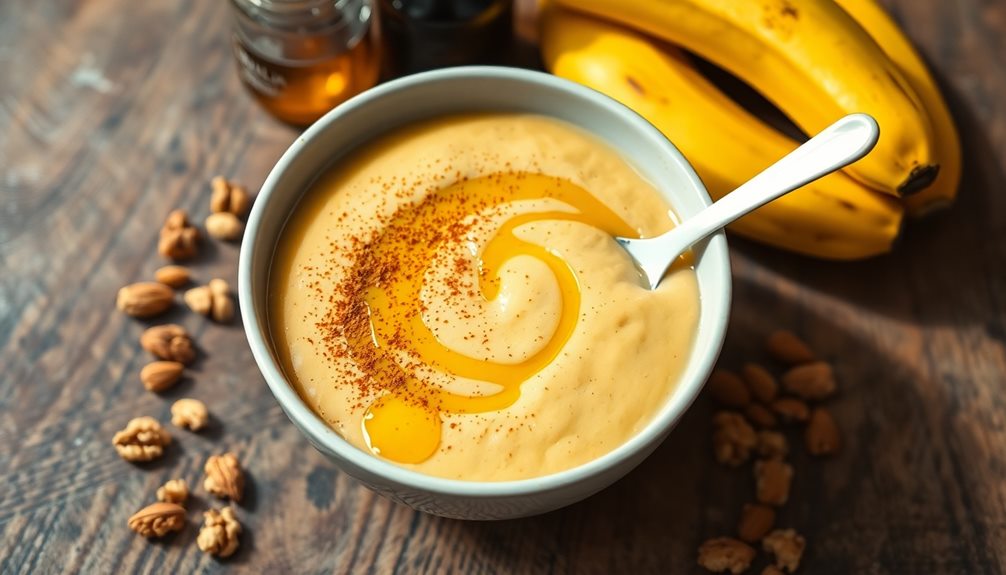Enjoy delicious, gut-friendly smoothies that won't trigger digestive woes! Low-FODMAP smoothies pack essential nutrients while avoiding pesky fermentable carbs. You'll find a basic recipe that's easy to customize, featuring lactose-free milk, low-FODMAP fruits like bananas and blueberries, and nutritious veggies. Blend up a refreshing treat, then top with fresh herbs for added flavor. Through trial and error, you'll discover your ideal flavor combos – like banana with almond butter or spinach with pineapple. With these soothing, well-balanced smoothies, you can nourish your body and soothe your gut. Continue reading to explore more delicious, gut-friendly blends.
Key Takeaways
- Low-FODMAP smoothies are designed to reduce the intake of fermentable carbohydrates that can trigger digestive issues, particularly in individuals with conditions like irritable bowel syndrome.
- The basic recipe for low-FODMAP smoothies includes a lactose-free liquid base, low-FODMAP fruits, vegetables, and optional add-ins like chia seeds, Greek yogurt, and nut butter.
- Blending all the ingredients together and garnishing with fresh herbs can enhance the flavor and nutritional value of the smoothie.
- Experimenting with different flavor combinations, adjusting sweetness levels, and finding the right balance of ingredients can help create a personalized low-FODMAP smoothie.
- Consuming low-FODMAP smoothies can be a delicious and gut-friendly way to improve overall well-being and manage digestive health.
History
Although the concept of low-FODMAP smoothies has been around for some time, their popularity has surged in recent years as more people have become aware of the benefits of following a low-FODMAP diet.
This dietary approach aims to reduce intake of fermentable oligosaccharides, disaccharides, monosaccharides, and polyols (FODMAPs), which can trigger digestive issues for individuals with conditions like irritable bowel syndrome (IBS). By crafting smoothies that are low in these problematic compounds, people can enjoy the nutritional benefits of fruits and vegetables while avoiding uncomfortable symptoms.
The rise of low-FODMAP smoothies can be attributed to the growing understanding of gut health and the role that diet plays in managing digestive disorders.
As more research has emerged on the effectiveness of the low-FODMAP approach, health-conscious individuals have sought out tasty and convenient ways to incorporate it into their daily routines.
The smooth, creamy texture of smoothies makes them an appealing option for those looking to nourish their bodies while supporting their digestive well-being.
Recipe
Smoothies can be a delightful and nutritious way to incorporate low-FODMAP ingredients into your diet. These beverages are easy to prepare and can be tailored to your taste preferences. By carefully selecting low-FODMAP fruits, vegetables, and other ingredients, you can enjoy a satisfying and gut-friendly smoothie.
Incorporating low-FODMAP smoothies into your routine can be a great way to increase your intake of essential nutrients while avoiding potential digestive discomfort associated with high-FODMAP foods. The recipe provided below offers a simple and delicious option that can be easily customized to suit your needs.
Ingredients:
- 1 cup lactose-free milk or almond milk
- 1 cup frozen blueberries
- 1/2 banana (ripe but not overripe)
- 1/2 cup spinach (fresh or frozen)
- 1 tablespoon chia seeds
- 1 tablespoon honey (optional)
Instructions:
In a high-speed blender, combine all the ingredients and blend until smooth and creamy. Adjust the consistency by adding more milk or ice, if desired. Pour the smoothie into a glass and enjoy immediately.
Tips:
- Feel free to experiment with other low-FODMAP fruits and vegetables, such as raspberries, kiwi, or pineapple, to create different flavor profiles.
- To make the smoothie more filling, consider adding a scoop of low-FODMAP protein powder or a tablespoon of almond butter.
- Adjust the sweetness to your preference by adding more or less honey.
- Serve the smoothie chilled for a refreshing and satisfying treat.
Cooking Steps
Blend all the ingredients until smooth and creamy.
Pour the mixture into glasses, then garnish with fresh herbs if desired.
Chill the smoothies before serving for a refreshing and chilled treat.
Step 1. Blend All Ingredients Until Smooth
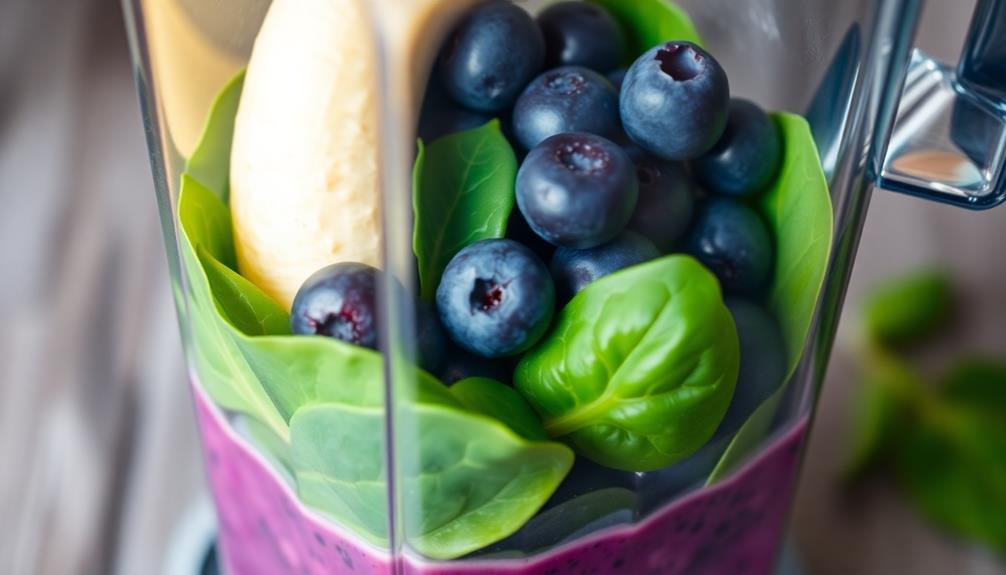
With all the ingredients gathered, it's time to start blending. Grab your blender and add the fruits, veggies, and any other low-FODMAP ingredients you've prepped.
Be sure to add the liquid ingredients first, as this will help everything blend more smoothly. Turn on the blender and let it work its magic, blending until the mixture is silky smooth and creamy. You may need to stop the blender and scrape down the sides a few times to ensure even blending.
Once the smoothie looks perfectly blended, give it a taste. If it needs a bit more sweetness or a different flavor, you can easily adjust by adding a touch more honey, vanilla, or other low-FODMAP mix-ins.
Step 2. Pour Into Glasses
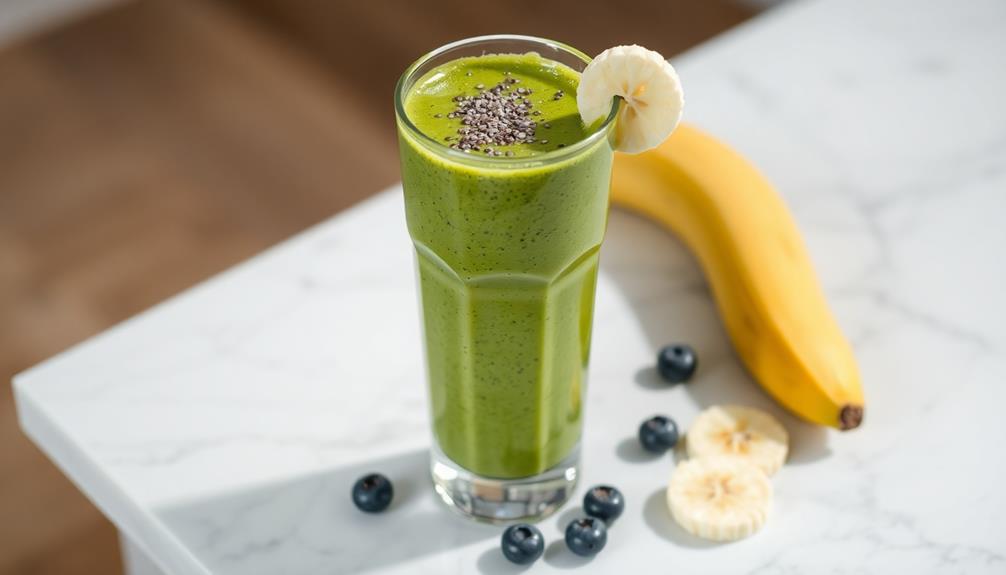
Carefully pour the blended smoothie mixture into your desired glasses or cups. Be sure to fill them to your preferred level, leaving a bit of room at the top for any garnishes or toppings you'd like to add. This step ensures your creamy, nutrient-dense smoothie is ready to enjoy.
Once poured, take a moment to admire the vibrant colors and smooth texture of your homemade creation. The low-FODMAP ingredients you selected blend together beautifully, making for a visually appealing and gut-friendly beverage.
Feel free to get creative with your presentation – you could top each smoothie with a sprinkle of cinnamon, a few berries, or a drizzle of honey for extra flavor and flair.
With your smoothies now neatly poured and ready to go, it's time to grab a straw, find a comfy spot, and savor the delicious, soothing sips. Sip slowly and savor each refreshing taste – your digestive system will thank you for this wholesome, low-FODMAP treat.
Step 3. Garnish With Fresh Herbs

To add the finishing touch to your low-FODMAP smoothies, consider garnishing them with fresh herbs. Herbs not only enhance the flavor of your smoothie but also provide additional nutrients and health benefits.
Try sprinkling a few leaves of mint, basil, or cilantro on top of your blended creation. The bright, aromatic flavors will complement the other ingredients and make your smoothie visually appealing.
When selecting herbs, choose ones that are low in FODMAPs, such as the ones mentioned above. Avoid high-FODMAP herbs like garlic, onion, and chives.
Gently wash the herbs and pat them dry before using. You can either tear the leaves by hand or chop them with a sharp knife to create a decorative garnish.
Arrange the fresh herbs on top of your smoothie in an aesthetically pleasing way. The vibrant colors and delicate textures will add a touch of elegance to your healthy, gut-friendly beverage.
Enjoy the interplay of flavors and the visual appeal of your beautifully garnished low-FODMAP smoothie. Add a sprinkle of chia seeds or a drizzle of coconut yogurt on top for an extra burst of texture and taste. For those who enjoy a little extra kick, consider experimenting with different lowfodmap sauce options such as a dash of pure maple syrup or a squeeze of fresh lemon juice. These small touches can elevate your low-FODMAP smoothie from delicious to truly exceptional.
Step 4. Chill Before Serving, if Desired

After blending your low-FODMAP smoothie, you may want to chill it before serving. Chilling your smoothie can enhance its refreshing flavour and texture.
If you prefer a thicker, frosty consistency, simply pop your freshly-blended smoothie in the fridge for 30 minutes to an hour. This brief chilling period allows the ingredients to meld and the texture to thicken up slightly.
Avoid over-chilling, though, as this can make your smoothie too icy.
When you're ready to enjoy, give your chilled smoothie a quick stir. The cold temperature will heighten the flavours, making each sip taste bright and vibrant.
Feel free to garnish with a sprig of mint, a sprinkle of cinnamon, or a few fresh berries for a beautiful presentation.
Sip and savor your deliciously chilled, gut-friendly smoothie. The perfect refreshment any time of day!
Step 5. Serve Immediately, or Refrigerate Until Chilled
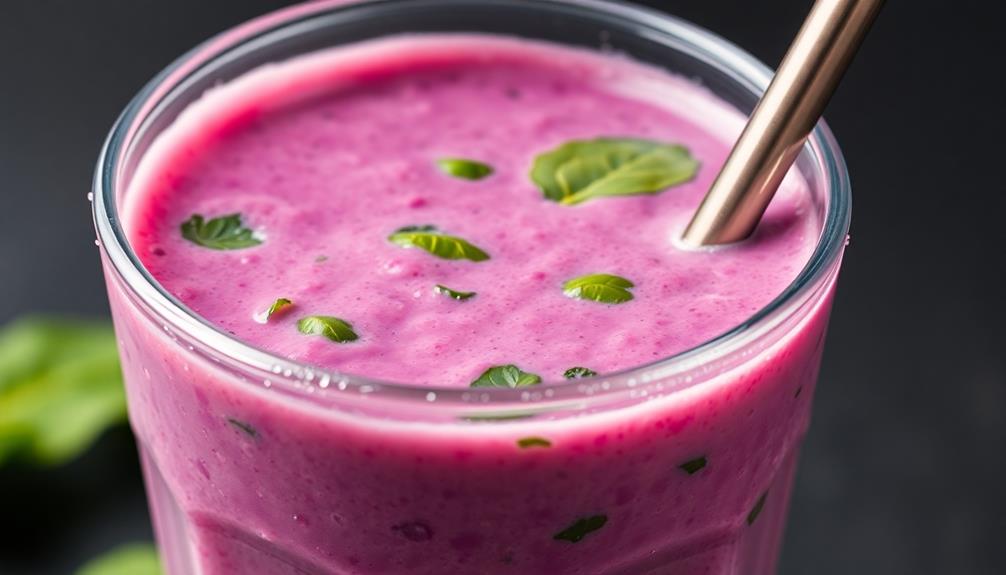
Once your low-FODMAP smoothie is blended, you can either serve it immediately or refrigerate it until chilled, depending on your preference.
If you prefer a thicker, colder smoothie, go ahead and pour it into glasses and pop them in the fridge for 30 minutes to an hour. This will allow the ingredients to chill and the flavors to meld.
Alternatively, if you're craving a refreshing, frosty treat right away, you can skip the chilling and serve the smoothie immediately. The choice is yours!
Just be sure to enjoy your low-FODMAP creation at the temperature you find most satisfying. Whether you sip it straight away or savor it after a quick chill, your gut-friendly blend will hit the spot.
Now, go on and indulge in your delicious, nutritious low-FODMAP smoothie – your body will thank you!
Final Thoughts
Ultimately, what's the key takeaway from exploring low-FODMAP smoothies? It's that you can enjoy delicious, gut-friendly blends that won't trigger your digestive issues.
These smoothies prove you don't have to sacrifice flavor or texture when following a low-FODMAP diet. Just keep a few things in mind. Be mindful of portion sizes, as even low-FODMAP ingredients can cause problems in large amounts.
And don't forget to blend in some protein, whether it's Greek yogurt, nut butter, or a protein powder. This will help keep you feeling full and satisfied.
Most importantly, have fun experimenting with different flavor combinations. The beauty of smoothies is their versatility.
Swap out ingredients, tweak the ratios, and find the blends that work best for your unique dietary needs and taste preferences. With a little trial and error, you'll be sipping on delightfully delicious low-FODMAP smoothies in no time.
Frequently Asked Questions
Can Low-Fodmap Smoothies Help With Irritable Bowel Syndrome?
Yes, low-FODMAP smoothies can help with irritable bowel syndrome. They're easy to digest and don't contain the types of carbs that can trigger IBS symptoms. Sipping on a low-FODMAP smoothie may provide relief and support your gut health.
Are Low-Fodmap Smoothies Suitable for People With Celiac Disease?
Yes, low-FODMAP smoothies can be suitable for people with celiac disease. Since they're made with low-FODMAP ingredients, they won't trigger your symptoms and can provide important nutrients to support your gut health.
How Long Can Low-Fodmap Smoothies Be Stored in the Refrigerator?
Low-FODMAP smoothies can generally be stored in the refrigerator for up to 2-3 days. However, you'll want to check the ingredients and preparation methods, as some components may affect the shelf life.
Can Low-Fodmap Smoothies Be Made With Frozen Fruits and Vegetables?
Absolutely! You can make low-FODMAP smoothies using frozen fruits and vegetables. They're just as nutritious and convenient as fresh ingredients. Plus, the frozen produce can help keep your smoothie chilled and refreshing.
Do Low-Fodmap Smoothies Require Special Blending Techniques or Equipment?
You don't need special blending techniques or equipment for low-FODMAP smoothies. A regular high-powered blender works just fine. The key is selecting the right low-FODMAP ingredients and proportions to create a smooth, gut-friendly blend.
